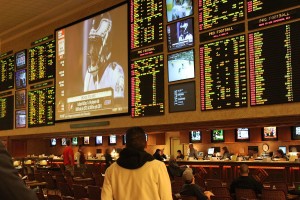How Betting Lines Work In Sports Betting
 For beginning sports gamblers, betting line can be confusing to understand. Unlike point spreads, which are concerned with who wins and by how much, a moneyline is solely dependent upon who wins. Moneylines are used most commonly in low-scoring games like baseball or hockey, but they may also be used in boxing and other sports.
For beginning sports gamblers, betting line can be confusing to understand. Unlike point spreads, which are concerned with who wins and by how much, a moneyline is solely dependent upon who wins. Moneylines are used most commonly in low-scoring games like baseball or hockey, but they may also be used in boxing and other sports.
Here is a guide on how actually betting lines works in Sports Betting.
1. What is Betting Line?
Before we start with how betting lines works, it is more important to understand what actually betting line is? Betting line is a not as complex as people think but still it throws the average person off and deters them from wanting to learn more about sports gambling. Betting lines are wagers that are made against the line. Line, is a number assigned by the bookmakers which handicaps one team and favors another when two teams play each other and one is perceived as being more likely to win.
For example, if the bookmaker believes Team A is a 10-point better team than Team B, the bookmaker can handicap Team A 10 points. The line bet becomes Team A to win by more than 10pts or Team B to get within 10 points. Both outcomes should be of equal odds roughly $1.90.
2. Who creates the betting lines?
Once you know all about betting line, the second that arises is, who creates betting line? Is it an individual, groups or clubs?
Sports gambling is a billion-dollar business, so a lot of thought goes into creating betting lines. Therefore, all sportsbooks have their in-house oddsmakers that are in charge of creating betting lines in the weeks and days leading up to games.
3. How betting lines are created?
There are a team of people employed by any bookmaker, usually referred to as Traders, Risk Analysts or Odds Compilers. Their job is to produce odds that closely represent the chance of an occurrence. Oddsmakers are often the brightest minds in the sportsbook and know all about the public perception of teams along with key statistics bettors use to make their picks. Oddsmakers sets his numbers through the initial line, also known as an ‘overnight line’ or ‘opening line.’ It is an educated guess of a starting point that oddsmakers believe will get equal action from bettors on both sides.
4. Why do betting lines change?
Betting lines change all the time for a number of different reasons. Sometimes, an injury to a key player will do it, while other times, a sudden weather change will cause a line to fluctuate. Also when a professional bettor places a large bet on one team, this also changes the line.
5. Does the betting line ever change after it is placed?
No, betting line never changes for a wager that has already been placed. This is both a positive and negative thing.
6. Why do some point spreads have half a point attached to them?
You might have seen that sometimes team A has a point spread of -6.5 or Team B has a point spread of 10.5 and think, “What? There aren’t any half-points in sports!” But you can treat these spreads the same way as you’d treat a regular point spread. If Team A wins by more than 6.5 points, you win. And if Team B loses by less than 10.5 points, then you win. You also have the option of “buying” half a point and making those lines -6 and +11, but “buying” points will cause your odds to increase and instead of paying a $10 vig on a $100 bet, you may end up paying a $20 or $25 vig for an extra half a point.
Nice post. I learn something new and challenging on sites I stumbleupon on a daily
basis. It’s always interesting to read content from
other writers and use a little something from other web sites.